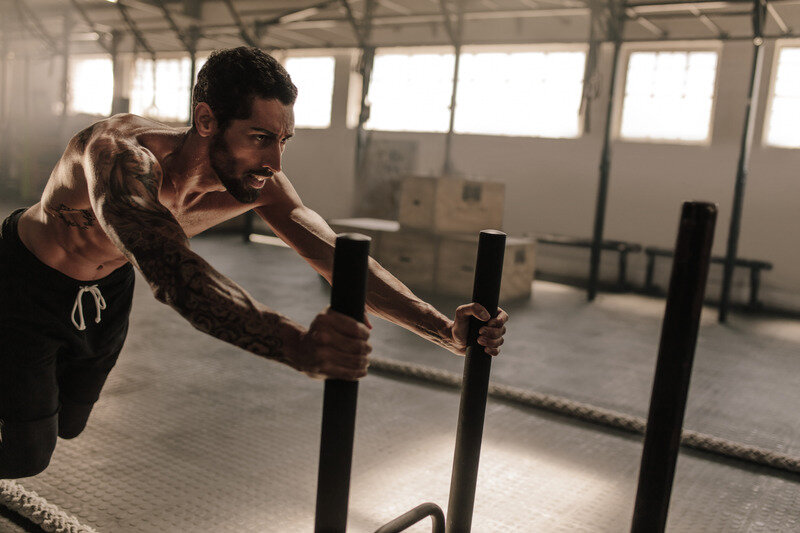Is Laksa Healthy? (3 Tips For Weight Loss)
There’s so much to say about Laksa and its unique flavors and textures.
It’s a dish that originates from South East Asia and is commonly found in Singapore and Malaysia.
It’s an extremely delicious dish that revolves around coconut milk and fish balls with a wide variety of toppings and vegetables that help compliment the dish.
Although Laksa is delicious, is it healthy?
Laksa is definitely a dish you should enjoy in moderation as it’s flavors come from a high fat content and a whopping 2,000 mg serving of sodium. However, if portions are controlled, Laksa is totally fine to eat and can fit into a healthy and sustainable diet.
Let’s take a look at some steps we can take to eat our favorite noodle dish while staying lean and healthy.
Understand What Goes Inside Laksa
Understand How Many Calories Are In Laksa
Make Sure To Workout Consistently & Track Calories
Now that we know the 3 steps to eat Laska and stay healthy, let’s get a deeper look at the importance of understanding what goes inside this dish and what its nutritional contents are.
Tip 1: Understand What Goes Inside Laksa
The first step of figuring out whether a food is healthy or not is to look at what makes up the dish and what its ingredients comprise.
There are really three components of Laksa that make up the dish which are the broth, the noodles, and the toppings.
Let’s take a look at each of these components and see what we can find.
The Broth
The broth is what really makes this dish stand out and is what provides the immense flavors that you get from the dish.
The key ingredient in this dish is definitely the coconut milk and the laksa paste which is a combination of many different ingredients such as garlic, ginger, soy sauce, sugar, fish sauce, chili paste, vegetable oil, and sriracha.
You can expect a lot of the calories coming from the paste as it contains a lot of fat and carbs.
Also, coconut milk is heavy as well as many Laksa dishes embed the coconut milk with some heavy cream to make it more substantial.
After the chili paste is made, the dish is then served with chicken stock and coconut milk with some aromatics such as ginger, garlic, lemon grass, and bean sprouts.
This is what gives the dish its acidity and completes the flavors in my opinion.
Overall, the broth is pretty fatty and contains a small amount of carbs so you can expect some calories to be coming out of there.
Let’s take a look at the noodles and see what we can find.
The Noodles
Laksa is usually made with rice noodles which has a very different consistency if you’re used to bouncier and chewier noodles.
It has a bit of a bite to it but eventually falls apart and melts in your mouth.
I like to think of them as weaker noodles that are more frail and breakable compared to traditional egg noodles.
A typical Laksa dish has around 2 cups of rice noodles which means that there will be a ton of carbs in this dish.
It’s to be expected, however, as it is a noodle dish.
A cup of rice noodles usually consists of 190 calories coming from mostly carbs and a slight amount of protein and fats.
Carbs are totally fine to eat as long as you are eating within a healthy range that your body is comfortable with.
It’s a macronutrient that fuels our movements and activity for the day so it should not be neglected.
Just make sure you’re responsible with your carbs and stay active to utilize the energy you get from them.
Let’s take a look at the last aspect of the dish which would have to be the amazing toppings.
The Toppings
The toppings, in my opinion, are what complete the dish as they add acidity and a refreshing bite from all the different veggies you get typically.
You can expect to find items such as lime, beansprouts, cilantro, or spinach to top off the dish.
There’s a lot of fat in Laksa so having a bit of acidity to mix with the creaminess really is perfect.
The toppings also consist of some proteins such as shredded chicken breast and fish balls.
This dish consists mostly of carbs and fats so having a lot of protein with this meal will definitely offer some much needed balance.
It’s perfect that chicken breast is used as a topping for Laksa as there would be no protein otherwise.
It’s crucial to add a balance of all three macronutrients into your diet as relying on fats and carbs will definitely get you overeating.
Let’s take a look at what Laksa consists of nutritionally and see how we can fit it into our diets.
Tip 2: Understand How Many Calories Goes Into Laksa
Now that we know what goes inside a typical bowl of Laksa, let’s take a look at what its nutritional contents are.
For a typical bowl of Laksa, there are 31 grams of fat, 64 grams of carbs and 23 grams of protein which comes out to a total of 610 calories per bowl.
There is a major problem with this dish in the form of too many fats compared to the amount of carbs and protein.
Fat is the highest macronutrient out of the three which means having more fat than protein in a single serving will put you at a disadvantage to eating healthy.
Fat has 9 kcals per 1 gram while protein and carbs have 4 kcals per 1 gram.
You can see in Laksa that there are 31 grams of fat with only 23 grams of protein.
This means that there are 279 calories coming from fat with only 92 coming from protein.
A bowl of Laksa can definitely take out the recommended fat range for the day which means its a dish that offers a high potential to overeat which will cause weight gain.
Our tip here is to make Laksa on your own and find alternatives to the fatty ingredients in the dish.
Also, you want to make sure that you add in lots of veggies and more chicken breast to make it safer to eat and as delicious as it usually is.
Let’s take a look at the importance of understanding how many calories we need to eat in a day and why we need to pair that with consistent workouts.
Tip 3: Make Sure To Workout Consistently & Track Calories
Food is energy that fuels our movements and activity throughout our day.
This means that, when we live sedentary lifestyles, we fail to utilize the energy we received from our food: especially if you don’t know much you’ve eaten in a day.
When you eat a food like Laksa, you can be unaware of the calories that it comes with and what it consists of nutritionally.
We found that it has a ton of fat and carbs with a whopping 610 calories.
If you tracked this food, you could definitely see its nutritional contents and fit into a day of food as you understand how many calories you need to eat and how much you have left for the day.
If you want a step by step guide on finding how many calories you need to eat in a day, then make sure to check out this article where we go over the details of eating your favorite foods while staying or getting lean.
https://www.aspirefitnesswalnut.com/how-to-actually-get-a-six-pack-after-30
Movement is what allows us to utilize the energy we receive in a day but muscle is what allows us to burn more of it at rest.
Muscle is built through adding resistance to our workouts and isolating each muscle and understanding their functions.
Here is a workout plan that will get you started with working out while teaching you how to utilize all the muscles in your body.
WOMEN
Monday (Full Upper):
Seated Shoulder Press: 4x20
Lateral Raises: 4x15
Lat Pulldowns: 4x12
Dumbbell Row: 3x10
Dumbbell Fly: 3x10
Knee Push Ups: 4x20
Weighted Crunches: 3x35
Wednesday (Back/Hamstrings/Biceps)
Assisted Pull Ups: 3x10
Lat Pulldowns: 4x12
Cable Row: 4x15
Stiff Leg Deadlift: 4x15
Hamstring Curl: 4x15
Bicep Curls: 3x10
Hammer Curls: 3x10
Friday: (Legs/Butt/Abs):
Squats: 5x5
Goblet Squats: 4x20
Glute Bridge: 4x20
Glute Kickbacks: 4x20 each leg
Jump Squats: 4x20
Weighted Crunches: 3x35
Leg Lifts: 3x35
MEN
Mon: Chest, Shoulders, Triceps, Abs (Push Day)
Bench Press: 3 sets 10 reps
Dumbbell Press: 4 sets 12 reps
Shoulder Press: 3 sets 10 reps
Lateral Raises: 3 sets 15 reps
Triceps Rope Push Down: 3 sets 15 reps
Cable Crunches: 4 sets 15 reps
Wed: Legs & Abs
Goblet Squats: 4 sets 20 reps
Weighted Walking Lunges: 2 sets 20 steps
Stiff Leg DeadLift (Romanian Deadlift): 4 sets 15 reps
Glute Bridges With Weight: 4 sets 20 reps
Jumping Squats With Resistance Bands: 5 sets 20 reps
Weighted Sit Ups: 4 sets 25 reps
Weighted Toe Touches: 4 sets 25 reps
Fri: Back & Biceps (Pull Day)
Assisted Pull Ups: 3 sets 10 reps
Lat Pulldowns: 4 sets 12 reps
Dumbbell Rows: 4 sets 10 reps (Each Side)
Seated Cable Rows: 4 sets 15 reps
Bicep Curls: 3 sets 10 reps
Hammer Curls: 3 sets 10 reps
Consistency and longevity are the two key factors when building muscle so there will be some commitment involved.
You can either go to the gym or build one for yourself.
It really just comes down to 3 pieces of equipment that you need to do most workouts.
These three are the workout bench, dumbbells, and gym flooring.
Check out our recommended gear page to see our best picks for these pieces of equipment here.
https://www.aspirefitnesswalnut.com/home-workout-equipment
If a home gym is not for you then getting a membership somewhere works too.
As long as you are starting your muscle building journey, we’re happy!
Stick with it for the long run and you’ll see how amazing the results can be.
There It Is!
In this article, we went over what goes inside a typical Laksa dish and what we can do to eat it while staying healthy.
If you want more information on your favorite Asian foods and some healthy tips you can implement into your life, then make sure to check out our other blogs!
RECENT POSTS
The Asian Weight Loss Cookbook
The 15 Fat Burning Meals Cookbook features our favorite recipes that you can use to get closer to your fitness goals.
Become your own personal trainer with the guidance of this book and make this the year you achieve your insurmountable fitness goals.
PHILLIP PAK
Phillip Pak is a fitness expert who has been training clients for 6 years. Throughout his fitness journey, Phill has done it all when it comes to diet and nutrition. He is now the owner of Aspire Fitness Walnut where his main goal is to help those who are seeking to find the best version of themselves. Phillip is also a NASM Certified Nutrition Coach (CNC) and a NASM Certified Personal Trainer (CPT).
















